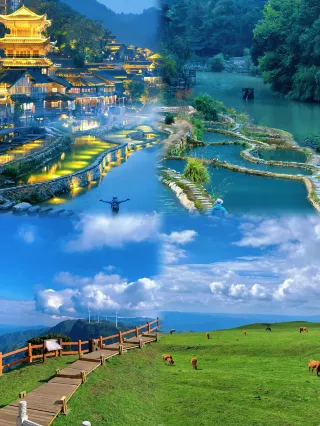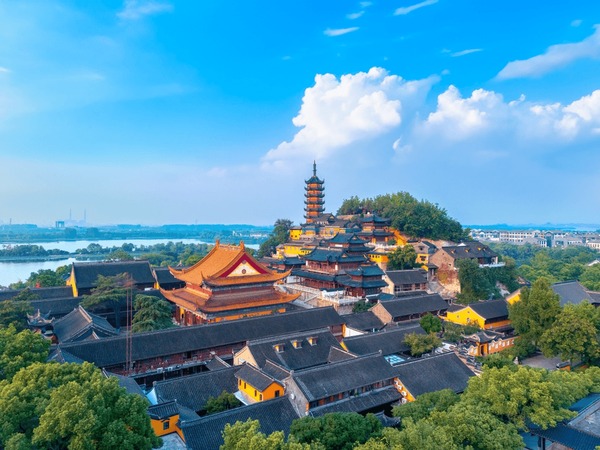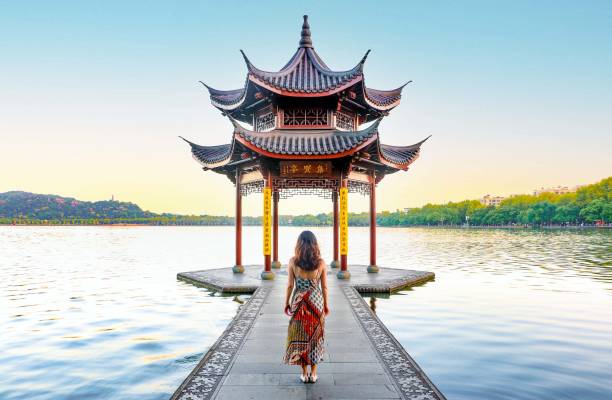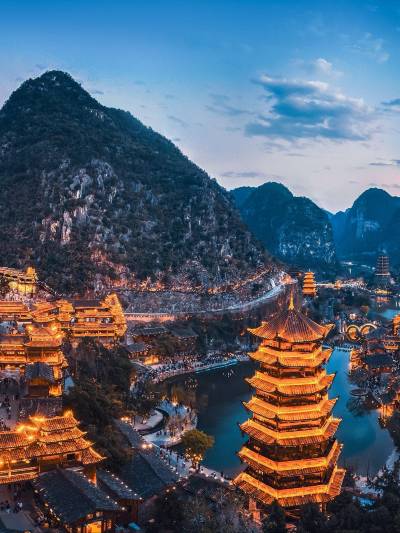Unveiling Zhenfeng Pagoda: A Cultural Marvel in China

An Essential Guide to Visiting Zhenfeng Pagoda
Nestled along the banks of the mighty Yangtze River in Anqing, Zhenfeng Pagoda (振风塔) stands as a testament to architectural elegance and spiritual significance. Often referred to as “The First Pagoda Along the Yangtze,” this stunning structure has captivated visitors for over 400 years with its intricate design and rich cultural heritage. Originally part of the Huguo Yongchang Temple, the pagoda was founded in 1568 during the Ming Dynasty and has since become a symbol of the city, embodying the beauty of traditional Chinese craftsmanship.
As you approach the pagoda, you’ll be greeted by its striking seven-story octagonal silhouette, resembling a graceful tapering cone. Each floor features ornate eaves and intricately carved arches, inviting you to explore the artistry that adorns its façade. Inside, the pagoda houses over a thousand Buddha statues and inscriptions that narrate historical myths, providing a glimpse into the spiritual tapestry that forms the heart of this sacred site.
Visiting Zhenfeng Pagoda is not just about admiring its architectural splendor; it is an opportunity to connect with a vibrant cultural tradition. Each year during the Mid-Autumn Festival, the pagoda becomes the focal point for a grand pilgrimage, where locals and travelers alike gather to witness the enchanting illumination of the tower’s shadow dancing upon the river’s surface. This annual event is steeped in legend and festivity, making it a unique experience for those fortunate enough to partake.
Whether you are a history enthusiast, a lover of architecture, or simply seeking to immerse yourself in the local culture, Zhenfeng Pagoda promises an unforgettable journey through time and tradition. Get ready to ascend the winding staircase to the top, where breathtaking views of the Yangtze River await, capturing the essence of Anqing’s natural beauty and historical grandeur.
In This Guide
- An Essential Guide to Visiting Zhenfeng Pagoda
- The Rich History and Legends of Zhenfeng Pagoda
- Main Highlights: What You Absolutely Can’t Miss
- Planning Your Visit: A Practical Guide
- Tickets: Prices, Booking, and Tips
- How to Get There: A Complete Transportation Guide
- Local Cuisine and Accommodation Nearby
- Frequently Asked Questions
- Final Thoughts on Your Trip
The Rich History and Legends of Zhenfeng Pagoda
Nestled along the picturesque banks of the Yangtze River, Zhenfeng Pagoda, also known historically as Huguo Yongchang Temple or the Ten Thousand Buddhas Pagoda, beckons with a rich tapestry of history and legend. Founded in 1568 during the second year of the Ming Longqing era, this architectural marvel has withstood the test of time for over 400 years, earning the affectionate title of “The First Pagoda Along the Yangtze River.” Locals often quip, “No need to see other pagodas after Anqing,” a testament to its significance and allure.
The pagoda itself is a stunning pavilion-style masonry structure soaring with seven octagonal floors. Its conical outline commands attention, particularly with its wide base that gracefully narrows as it ascends. Each floor features intricately designed octagonal ventricles and double-copy Chinese arches that add to its architectural elegance. The pagoda is adorned with over 1,000 Buddha statues and historical inscriptions, weaving a narrative of both spiritual reverence and artistic expression.
Inside the walls, visitors will find statues of notable Buddhist figures such as Amitabha Buddha, Maitreya Buddha, and Wufang Buddha that celebrate the rich tapestry of Buddhist culture. The intricate artistry and architectural details not only showcase the craftsmanship of the era but also invite contemplation and reflection.
As night falls during the Mid-Autumn Festival on August 15th each year, a magical spectacle occurs. The ice wheel illuminates the night sky, casting shadows of the pagoda across the river, creating a mesmerizing scene that locals believe represents the gathering of pagodas from both banks of the Yangtze. This annual pilgrimage to Zhenfeng Pagoda becomes a grand occasion, drawing both devotees and visitors eager to partake in the festivities.
The legends surrounding Zhenfeng Pagoda add an enchanting layer to its history. It is said that the pagoda has witnessed countless tales of love, loss, and devotion, with stories of local monks and devotees who have sought enlightenment within its walls. The whispers of the past seem to echo through the corridors, inviting travelers to connect with the spiritual heritage that envelops this historic site.
For those who venture to Zhenfeng Pagoda, a climb to the top rewards visitors with breathtaking panoramic views of the Yangtze River and the surrounding landscape, a fitting tribute to the pagoda’s stature as a beacon of history and culture. A visit here is not merely a sightseeing endeavor; it is an invitation to step back in time, to immerse oneself in the legends that have shaped this remarkable structure, and to appreciate the artistry and devotion that have made Zhenfeng Pagoda a cherished landmark of Anqing.

Zhenfeng Pagoda.
Main Highlights: What You Absolutely Can’t Miss
When exploring the enchanting Zhenfeng Pagoda, also known as the “First Pagoda Along the Yangtze River,” you’ll find a wealth of history, culture, and stunning architectural beauty. Here are the main highlights that you simply can’t miss:
Architectural Marvel
Zhenfeng Pagoda stands as a testament to ancient craftsmanship. Erected in 1568 during the Ming dynasty, it boasts a distinctive pavilion-style structure with seven octagonal levels tapering to a conical peak. Each floor features intricate double-eaved arches and a wide base that creates a majestic silhouette against the backdrop of the Yangtze River. Take a moment to admire the detailed carvings and the unique octagonal design that sets this pagoda apart.
Breathtaking Views
Once you’ve climbed to the top, prepare to be rewarded with panoramic views of the Yangtze River and the surrounding landscapes. The sight of the river winding through the countryside is nothing short of breathtaking. It’s a perfect spot for photography, especially during sunset when the golden light casts a magical glow over the water.
Spiritual Significance
Inside the pagoda, you’ll discover a serene atmosphere enriched by the presence of various Buddhas, including Amitabha, Maitreya, and the Wufang Buddha. The interior is adorned with over 1,000 Buddha statues and numerous inscriptions that narrate historical myths and stories, providing a deep insight into the spiritual heritage of this site.
Annual Pilgrimage
If your visit coincides with the Mid-Autumn Festival on August 15th, you are in for a treat. This is when the pagoda becomes the focal point of a grand pilgrimage, with thousands gathering to witness the ethereal sight of ice wheels and shadows reflecting on the water. The local lore surrounding this event adds an extra layer of magic to your visit.
Cultural Experience
A visit to Zhenfeng Pagoda is not just about the site itself; it’s an immersion into the vibrant culture of Anqing. Located near the Yingjiang Temple, which is another landmark of the area, you can explore the rich spiritual and cultural narrative of this ancient town.
Convenient Accessibility
Easily accessible from downtown Anqing, Zhenfeng Pagoda can be reached via public transport or a short walk from nearby attractions. With an entry fee of just ¥10 (approximately $1.50), it’s an affordable opportunity to delve into local history and enjoy a leisurely day of exploration.
Nearby Attractions
Consider extending your visit to include neighboring sites like Linghu Park and Daopa Lion Pedestrian Street, where you can enjoy the blend of nature and historical architecture. Indulge in local delicacies at nearby eateries, making your trip both a cultural and culinary adventure.
Zhenfeng Pagoda encapsulates the essence of Anqing—a city steeped in history, spirituality, and breathtaking views. Don’t miss the chance to experience this remarkable landmark during your travels!

Zhenfeng Pagoda.
Planning Your Visit: A Practical Guide
Planning Your Visit: A Practical Guide to Zhenfeng Pagoda
When planning your visit to Zhenfeng Pagoda (振风塔), an iconic landmark located in Anqing, Anhui Province, there are several aspects to consider to ensure a smooth and enjoyable experience. From transportation and accommodation to local attractions, this guide will help you navigate your trip to this historic site.
Getting There
By Train:
The most convenient way to reach Anqing is via high-speed rail. You can take a train from Hefei South Station to Anqing, which takes approximately 1 hour and 15 minutes and costs around ¥76 (approximately $11).
Local Transportation:
Once in Anqing, the pagoda is easily accessible by local bus or taxi. The starting fare for taxis is about ¥5 ($0.75), while bus fares are incredibly budget-friendly, ranging from ¥0.5 to ¥1 ($0.07 to $0.15).
Visiting Hours & Tickets
Zhenfeng Pagoda is usually open from 8:00 AM to 5:00 PM. The entrance fee is ¥10 ($1.50), with an additional ¥20 ($3) if you wish to climb the pagoda for panoramic views of the Yangtze River. It is advisable to allocate around 1 to 1.5 hours for your visit to fully appreciate the architecture and surroundings.
What to Expect
Built during the Ming Dynasty in 1568, Zhenfeng Pagoda is not just a historical structure; it is a spiritual haven. The pagoda has seven octagonal floors, each adorned with intricate carvings and over a thousand Buddha statues. Inside, you can find representations of Amitabha Buddha, Maitreya Buddha, and Wufang Buddha, all nestled within a beautifully crafted pavilion-style structure.
Make sure to visit during the Mid-Autumn Festival (August 15 on the lunar calendar), when the pagoda is particularly enchanting, and the surrounding river comes alive with cultural festivities.
Nearby Attractions
While Zhenfeng Pagoda is a must-visit, Anqing offers numerous other attractions worth exploring:
- Yingjiang Temple: Adjacent to the pagoda, this ancient temple is known for its beautiful architecture and serene atmosphere.
- Linghu Park: A scenic urban park that is perfect for leisurely walks and picnics, featuring picturesque lakes and pavilions.
- Anqing Museum: Dive into the local history and culture, showcasing the rich heritage of the region.
- Daopa Lion Pedestrian Street: This lively street is lined with Ming and Qing-era buildings, shops, and eateries, offering a taste of local life.
Where to Stay
For a comfortable stay, consider the James Joyce Coffetel near the Anqing High-Speed Rail Station, offering modern amenities at affordable rates (around ¥168 or $24 per night). This convenient location allows easy access to both the pagoda and other attractions.
Local Cuisine
No visit to Anqing is complete without indulging in its culinary offerings. Here are some local dishes you must try:
- Beizheng Meatball Soup: A delicious and hearty dish that is quite popular among locals.
- Zhanfei Beef Noodles: Renowned for its rich flavor and tender beef, this is a must-try for noodle lovers.
- Huangmei Opera Snacks: Sample local street food while enjoying performances of this traditional art form.
Tips for Your Visit
- Plan Ahead: Many attractions close between 5:00 PM and 6:00 PM, so plan your itinerary accordingly.
- Dress Appropriately: Weather can vary, so wear comfortable clothing and shoes, and bring sun protection in the summer.
- Stay Hydrated: Carry a bottle of water, especially if you plan to explore the pagoda and surrounding areas.
With this practical guide in hand, you’re ready to embark on your journey to Zhenfeng Pagoda, a treasure of Chinese history and culture nestled along the banks of the Yangtze River. Enjoy your visit!

Zhenfeng Pagoda.
Tickets: Prices, Booking, and Tips
Visiting Zhenfeng Pagoda is a must for anyone exploring the enchanting city of Anqing. This historic site, also known as the “First Pagoda Along the Yangtze River,” offers not only stunning views but also a deep dive into the region’s rich cultural heritage.
Ticket Information
- General Admission: Approximately ¥10 (around $1.50 USD). This ticket grants you access to the Yingjiang Temple and the surrounding grounds.
- Pagoda Climb: If you’re keen to ascend the tower for breathtaking views of the Yangtze River, there is an additional fee of ¥20 (about $3 USD). The climb is well worth it, providing an unforgettable perspective of the area.
Booking Tips
- Purchase On-site: Tickets can be easily purchased at the entrance to the pagoda. It’s advisable to arrive early in the day to avoid crowds, especially during weekends and holidays.
- Group Discounts: If you’re traveling with a group, inquire about any available group discounts at the ticket counter.
Visiting Hours
Zhenfeng Pagoda typically opens around 8:00 AM and closes at 6:00 PM. However, hours can vary depending on the season or special events, so it’s wise to check in advance or call ahead to confirm.
Best Time to Visit
For the most enjoyable experience, consider visiting during the early morning or late afternoon. The light is perfect for photography, and the cooler temperatures will make your climb more comfortable. Additionally, visiting during the Mid-Autumn Festival on August 15th offers a unique experience, as the pagoda hosts special events that attract visitors from all around.
Accessibility
The pagoda and its surroundings are generally accessible, but be prepared for some stairs as you ascend the tower. If you have mobility concerns, it’s advisable to check with the site staff for assistance.
By planning your visit with these tips in mind, you’ll be well-prepared to enjoy the historical and cultural marvel that is Zhenfeng Pagoda. Happy travels!
How to Get There: A Complete Transportation Guide
To reach the stunning Zhenfeng Pagoda, also known as the “King of the Yangtze River Pagoda,” located in Anqing, China, you’ll find several convenient transportation options. Whether you’re arriving by air, rail, or bus, here’s a comprehensive guide to help you navigate your journey seamlessly.
By Air
If you’re flying into China, the closest major airport to Anqing is Anqing Tianzhushan Airport (AQG). Located approximately 20 kilometers from the city center, this airport primarily serves domestic flights. From the airport, you can take a taxi or pre-arranged airport transfer to reach the pagoda.
- Taxi: A taxi ride from the airport to Zhenfeng Pagoda will take about 30 minutes and cost around ¥50-70.
- Airport Transfer: Many hotels in Anqing offer airport shuttle services. Check with your accommodation for availability and pricing.
By Train
Anqing is well-connected by train, making it easy for travelers to access the city from major hubs like Hefei and Wuhan.
- High-Speed Train: From Hefei South Railway Station, take the high-speed train to Anqing. The journey takes approximately 1 hour and 15 minutes, with tickets priced around ¥76.
-
Arrival at Anqing Railway Station: Once you arrive, you can take a taxi or a local bus to Zhenfeng Pagoda.
-
Taxi: The taxi ride from the train station to the pagoda will take about 15-20 minutes and cost around ¥20-30.
- Public Transportation: Anqing has a network of local buses that can take you close to the pagoda, with fares typically around ¥1-3.
By Bus
If you prefer to travel by bus, several long-distance buses connect Anqing with nearby cities.
-
Intercity Buses: Buses from cities like Hefei, Wuhu, and Nanjing frequently arrive at Anqing’s main bus station. Upon arrival, you can take a taxi or local bus to reach the pagoda.
-
Taxi: Expect a similar fare and travel time as mentioned above.
- Local Buses: Check the local bus routes for options that can take you directly or within walking distance of Zhenfeng Pagoda.
Local Transportation Tips
- Taxi Services: Taxis in Anqing are affordable, with a starting fare of around ¥5. Ride-sharing apps may also be available for convenience.
- Public Buses: Buses are a cost-effective way to get around. The local bus system is efficient, and routes are generally well-marked.
- Walking: If you’re staying nearby, Zhenfeng Pagoda is also accessible by foot, especially if you want to soak in the local atmosphere along the way.
Recommended Routes
For the most scenic journey, consider taking the bus along the Yangtze River, which offers beautiful views and a chance to experience local life. Additionally, if you’re planning to climb the Zhenfeng Pagoda, allocate about 1 hour for your visit to fully appreciate its historical significance and stunning architecture.
With these transportation options, reaching Zhenfeng Pagoda is straightforward, allowing you to focus on enjoying the breathtaking views and the rich history that this iconic landmark has to offer. Happy travels!

Zhenfeng Pagoda.
Local Cuisine and Accommodation Nearby
When visiting the majestic Zhenfeng Pagoda, not only can you immerse yourself in its historical grandeur, but you’re also in for a treat with the local cuisine and cozy accommodations that enhance your travel experience. Here’s a curated selection of delightful dining options and nearby places to stay, ensuring that your journey through Anqing is both flavorful and comfortable.
Culinary Delights
Beizheng Meatball Shop
A beloved local eatery, this spot is renowned for its hearty fried noodles paired with a savory ham and pork liver meatball soup. Expect generous portions at wallet-friendly prices, all boasting that authentic wok hei flavor that makes Chinese food so irresistible.
Zhanfei Beef Noodles
Widely regarded as the must-try dish in Anqing, Zhanfei’s beef noodles have earned a loyal following among locals. The rich broth, tender beef, and handmade noodles create a satisfying meal that you won’t want to miss.
Shanghai Old Lady Snack Shop
For a quick bite, this snack shop offers incredible value with its delicious dishes. The expertly crafted sauces elevate simple ingredients into mouthwatering treats.
Pioneer Lane Shredded Pork Noodles
Famous for its flavorful dishes, this establishment is a great place to sample shredded pork noodles. Be sure to arrive early, as some popular items, like the Post Office fried noodles, often sell out by mid-afternoon.
Hu’er Pan-Fried Dumplings
Crispy on the outside and bursting with juicy meat filling on the inside, these dumplings are a treat for your taste buds. A perfect snack or side dish to accompany your meal.
Bianjing Fried Chicken
A local twist on fried chicken, this spot serves skewered meat that’s sure to satisfy your cravings. It’s Anqing’s take on fast food, providing a quick and tasty option.
Comfortable Stays
James Joyce Coffetel
Located conveniently near the Anqing High-Speed Rail Station, this hotel offers modern accommodations with a cozy ambiance. Room rates start at approximately ¥168, making it an excellent choice for budget-conscious travelers looking for comfort and convenience.
Old Anqing Restaurant
While primarily known for its delicious dishes, this restaurant also provides a warm atmosphere where you can enjoy your meals. Staying nearby allows for a seamless dining experience after a day of exploration.
Explore and Indulge
After exploring the stunning Zhenfeng Pagoda and its surroundings, treat yourself to a variety of local flavors that capture the essence of Anqing. Whether you’re savoring a steaming bowl of beef noodles or enjoying crispy dumplings, the culinary offerings here are sure to enhance your travel experience. Pair these delightful meals with a comfortable night’s stay, and you’ll find yourself wanting to extend your visit to this charming riverside city.

Zhenfeng Pagoda.
Frequently Asked Questions
-
What is Zhenfeng Pagoda?
Zhenfeng Pagoda, also known as the “King of the Yangtze River Pagoda,” is a historic seven-story structure located inside Yingjiang Temple in Anqing, China. Originally built in 1568 AD, it boasts a stunning pavilion-style design and is renowned for its thousands of Buddha statues and inscriptions, making it a significant cultural and spiritual site. -
How much does it cost to visit Zhenfeng Pagoda?
The entry fee for Zhenfeng Pagoda is approximately ¥10 (around $1.50), and if you wish to climb to the top for panoramic views of the Yangtze River, the total cost is about ¥20 (around $3). -
What are the best times to visit?
The pagoda is open year-round, but late afternoons provide a stunning view as the sun sets over the Yangtze River. Additionally, visiting during the Mid-Autumn Festival on August 15th offers a unique experience with the tower shadows reflecting on the river. -
How do I get to Zhenfeng Pagoda?
Zhenfeng Pagoda is located at No. 148 Yanjiang East Road in Yingjiang District, Anqing. You can reach it via public transport such as buses or taxis, which are reasonably priced. The nearest high-speed rail station is Anqing Station, from where you can take a taxi or a local bus. -
What should I wear when visiting?
Comfortable walking shoes are recommended as you will be climbing stairs to reach the top of the pagoda. Dress in layers, especially if you are visiting in winter, as it can get chilly, particularly in the evening. -
Are there any nearby attractions to explore after visiting the pagoda?
Yes! After visiting Zhenfeng Pagoda, consider exploring Yingjiang Temple, Linghu Park, and the historical streets of Anqing. You can also enjoy local cuisine at nearby eateries featuring traditional dishes. -
Is it suitable for children and elderly visitors?
While the pagoda is accessible to families, climbing to the top may be challenging for elderly visitors or very young children. However, the beautiful surroundings and lower levels of the pagoda can still be enjoyed by all. -
Are there any special events or festivals at Zhenfeng Pagoda?
The Mid-Autumn Festival is particularly special, featuring traditional celebrations and rituals. Additionally, various cultural events and performances may occur throughout the year, so it’s worth checking local listings for any scheduled festivities during your visit.
Final Thoughts on Your Trip
As your journey draws to a close, take a moment to reflect on the timeless beauty and cultural significance of Zhenfeng Pagoda. Nestled along the majestic Yangtze River, this architectural wonder stands not just as a monument of history but as a testament to the rich spiritual heritage of Anqing. Standing tall for over four centuries, the pagoda invites you to explore its intricacies, from the serene statues within to the breathtaking views from its heights.
Visiting Zhenfeng Pagoda isn’t merely about gazing at an impressive structure; it’s about immersing yourself in the stories that echo through its halls and the legends that swirl in the air. As you climb its seven octagonal floors, you’ll feel a connection to the past and a sense of peace that resonates with the tranquil river flowing below.
Whether you’re a history buff, a spiritual seeker, or simply a traveler in search of beauty, Zhenfeng Pagoda offers a unique experience that enriches the soul. So as you leave this remarkable site, carry with you the echoes of the past and the vibrant spirit of Anqing—a city where time-honored traditions blend seamlessly with modern life. Until your next adventure, may the memories of this enchanting pagoda inspire your travels and ignite your curiosity about the world’s treasures.